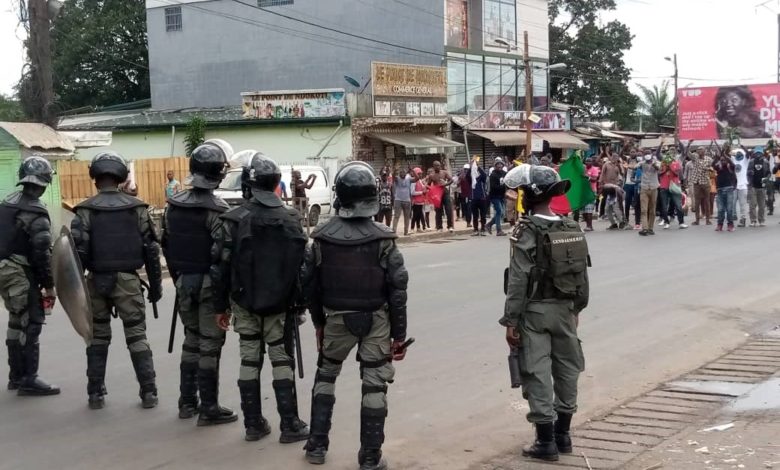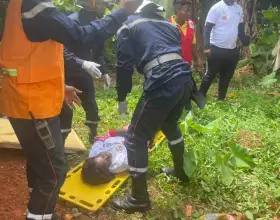Francophone Opposition Leader Rallies Protesters Against Biya’s Presidency

Since 2017, September 22 has come to mean different things for different political interests in Cameroon.
To the English-speaking Cameroonian, it was on this date in 2017 that some Anglophone Cameroonians rose up against the Francophone dominated regime in Yaounde, calling for a separate English speaking nation to be known as Southern Cameroons to some and Ambazonia to others.
This date gained another significance on Tuesday, September 22, 2020, as it was the date on which Cameroon’s leading opposition party, the Cameroon Renaissance Movement (CRM), and its leader, Prof. Maurice Kamto, called for a popular uprising to chase long-serving 87-year-old President Paul Biya out of power.
The outcome of Tuesday ’s activities and the success or failure to achieve the objectives, can be analysed in various ways depending on which side the individual leans. It also depends on what the objective of the day was supposed to be for various individuals and opinion groups in the country.
The CRM which decided on Tuesday’s demonstrations originally said they were intended to force the government to call off the regional elections slated for December 6, 2020, and only hold them after the resolution of the Anglophone problem which has led to an armed insurrection in the two English-speaking regions of the country.
The demonstrations were also intended to force the government to revise the electoral code and make for the holding of more transparent elections.
However, due to the cacophony into which social media have plunged political action in Cameroon, as elsewhere around the world, the goal of the activities was so bungled as various political groups jumped into the streets for different reasons.
Whilst the CRM leadership has continued to insist that the demonstrations were intended to be peaceful/non-violent, its militants both within and outside the country continued to dub them“an uprising to chase Biya out of power”. And this to the extent that some social media outlets started terming September 22 as “the D-Day to end Biya’s tyranny and kleptocracy”.
The government on its part contributed in adding its own meaning and tension to the activities..
Prior to the day, the government deployed an unprecedented armada of military hardware and personnel in major towns of the country and continued to term the scheduled demonstrations as an “insurrection” in one breathe, a “rebellion” in another and “a plot against the legitimate government”.
That the day has come and gone with Biya still in power is seen as a big victory for Biya and his government by supporters of the regime.
“It was a resounding failure. It demonstrated, if there was the need, that Kamto and his ilk have been vomitted by even his own base,” a commentator on the government-owned Cameroon Radio Television (CRTV), said.
The opposition and civil society outfits that supported the CRM/Kamto initiative on their part insist the outing was a resounding success.
“Our reason of calling for demonstrations was not to overthrown Biya’s authoritarian government. Our intention was to draw national and international attention to the kleptocracy and authoritarian nation into which Biya has turned this country,” said Kamdem Simo, an official of the CRM in Douala.
“Since the inception of our civil society organisation, our goal has always been to militate for regime change in Cameroon.
“We saw the call by the CRM for Cameroonians to come out in large numbers and demonstrate on September 22 as a step towards achieving our goal of regime change. That is why we decided to participate in the demonstrations of yesterday”, Dominic Angoula, a militant of the Stand Up 4 Cameroon movement told HumAngle on Wednesday.
“As far as we are concerned, our actions of yesterday were a huge success due to the turnout of the masses and the political slogans they both chanted and displayed by way of placards,” chipped in another activist of Stand Up 4 Cameroon.
Opinions within the Social Democratic Front (SDF), which was Cameroon’s leading opposition party before the advent of the CRM are divided because there was no unanimity in the party’s participation in the demonstrations.
The leader of the party, Ni John Fru Ndi, was against the party’s participation in the demonstrations. He was supported by the First National Vice-President of the party, Joshuah Osih, who was its presidential candidate during the 2018 election.
On the other hand, Nintcheu Jean Michel, the Littoral Chairman of the party, had called for the massive turnout of SDF militants to participate in the demonstrations.
According to Nintcheu, “the Cameroonian people of change by the September 22 demonstrations, once again marked an important point in the fight for the liberties and change in Cameroon”.
In a statement shortly after the end of the demonstrations in Douala, Nintcheu declared that the objective of the demonstrations was “not to immediately overthrow the government of Mr. Biya today.
“Nobody had even pretended that in one single demonstration, we can overthrow the over 30 years old regime of Mr. Biya. The objective was to maintain the initiative of actions on the ground, to force the government to panic and withdraw.
“Each time the Biya regime panics, which it does each time peaceful demonstrations are announced, it is already a victory for the progressive forces.”
Being a Bamilike as CRM leader, Kamto, some ruling party bigwigs were quick to point out that Nintcheu was merely backing a plot hatched by his tribe’s people to destabilise and overthrow the Biya regime.
Some truth transpired in this school of thought when it turned out that besides Douala where there was a rather impressive turnout, mostly towns and villages in the Bamileke Western region took part in the demonstrations.
There was a feeble attempt by some CRM militants in Yaounde to participate in the “uprising” as deemed by government, but this was quickly nipped in the bud by the impressive arsenal of military hardware and personnel who were deployed in strategic arteries of the national capital.
Police water cannons were seen chasing demonstrators and motor bike riders through the streets of Yaounde as some curious watchers either cheered on the security forces or shouted in support of the demonstrators.
There were virtually no demonstrations in English-speaking Cameroon, with the exception of Bamenda, the epicentre of the Anglophone revolution. This could easily be attributed to the significance of the September 22 date to some Anglophones.
While some separatist leaders in the diaspora saw in Kamto’s choice of September 22 as an attempt to hijack the significance of the date to his political advantage, other Anglophones saw the Kamto call to demonstrate as a purely “Francophone” affair.
Other English-speaking Cameroonians read cynical meanings into the activities of the day.
“Throughout the towns where demonstrations were held in French-speaking Cameroon, no lives were lost. Soldiers did not shoot at anybody. However, four Anglophones were shot dead in Bamenda on the same day by soldiers. Doesn’t this send any message to you? These people (Francophes) are so happy to kill us (Anglophones)”, one angry street hawker in Bamenda told HumAngle.
Overall, the slaughter of protesters that was hyped before the “D-Day” did not happen and protest organisers, who predicted several of theirs would be gunned down by the military, are quick to point out that this did not happen because of the sensitisation of the international community by protest organisers to the danger that loomed on that day.
“I think the absence of blood in the protests could, to a large extent, be attributed to the fact that some diplomatic missions in Yaounde called on government to rather accompany the demonstrators on their trajectory to avoid violence rather than confronting them”, opined a European diplomat who elected for anonymity because of his status.
To water down the rather mitigated outcome of the demonstrations, organisers declared that they would continue demonstrating daily until December 6 when the regional elections are scheduled to be held.
Support Our Journalism
There are millions of ordinary people affected by conflict in Africa whose stories are missing in the mainstream media. HumAngle is determined to tell those challenging and under-reported stories, hoping that the people impacted by these conflicts will find the safety and security they deserve.
To ensure that we continue to provide public service coverage, we have a small favour to ask you. We want you to be part of our journalistic endeavour by contributing a token to us.
Your donation will further promote a robust, free, and independent media.
Donate HereStay Closer To The Stories That Matter




